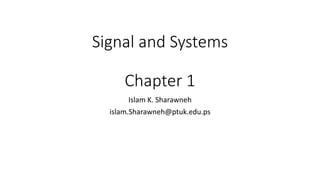signal and system chapter1-part2.pdf
•
0 likes•18 views
signal and system chapter1-part2.pdf
Report
Share
Report
Share
Download to read offline

Recommended
Recommended
More Related Content
Similar to signal and system chapter1-part2.pdf
Similar to signal and system chapter1-part2.pdf (20)
Biomedical Control Systems - THE CONCEPT OF STABILITY & ROOT LOCUS TECHNIQUE ...

Biomedical Control Systems - THE CONCEPT OF STABILITY & ROOT LOCUS TECHNIQUE ...
automatic control, Basic Definitions, Classification of Control systems, Requ...

automatic control, Basic Definitions, Classification of Control systems, Requ...
Lab1_Introduction_to_Analog_Control_Laboratory_18_12_2023.pdf

Lab1_Introduction_to_Analog_Control_Laboratory_18_12_2023.pdf
More from islamsharawneh
More from islamsharawneh (8)
signals and systems chapter3-part4.0.pdf_signals and systems chapter3-part4.0...

signals and systems chapter3-part4.0.pdf_signals and systems chapter3-part4.0...
signals and systems chapter3-part3_signals and systems chapter3-part3.pdf

signals and systems chapter3-part3_signals and systems chapter3-part3.pdf
signals and systems chapter4-part5_signals and systems chapter4-part5

signals and systems chapter4-part5_signals and systems chapter4-part5
signals and systems chapter4_signals and systems chapter4

signals and systems chapter4_signals and systems chapter4
System _ Technik _ Electronic LAB _ Semiconductor Components (2023).pdf

System _ Technik _ Electronic LAB _ Semiconductor Components (2023).pdf
Recently uploaded
Differences between analog and digital communicationanalog-vs-digital-communication (concept of analog and digital).pptx

analog-vs-digital-communication (concept of analog and digital).pptxKarpagam Institute of Teechnology
Recently uploaded (20)
Seismic Hazard Assessment Software in Python by Prof. Dr. Costas Sachpazis

Seismic Hazard Assessment Software in Python by Prof. Dr. Costas Sachpazis
What is Coordinate Measuring Machine? CMM Types, Features, Functions

What is Coordinate Measuring Machine? CMM Types, Features, Functions
Involute of a circle,Square, pentagon,HexagonInvolute_Engineering Drawing.pdf

Involute of a circle,Square, pentagon,HexagonInvolute_Engineering Drawing.pdf
analog-vs-digital-communication (concept of analog and digital).pptx

analog-vs-digital-communication (concept of analog and digital).pptx
Independent Solar-Powered Electric Vehicle Charging Station

Independent Solar-Powered Electric Vehicle Charging Station
History of Indian Railways - the story of Growth & Modernization

History of Indian Railways - the story of Growth & Modernization
Artificial intelligence presentation2-171219131633.pdf

Artificial intelligence presentation2-171219131633.pdf
UNIT-2 image enhancement.pdf Image Processing Unit 2 AKTU

UNIT-2 image enhancement.pdf Image Processing Unit 2 AKTU
Developing a smart system for infant incubators using the internet of things ...

Developing a smart system for infant incubators using the internet of things ...
Research Methodolgy & Intellectual Property Rights Series 1

Research Methodolgy & Intellectual Property Rights Series 1
Theory of Time 2024 (Universal Theory for Everything)

Theory of Time 2024 (Universal Theory for Everything)
signal and system chapter1-part2.pdf
- 1. Signal and Systems Chapter 1 Islam K. Sharawneh islam.Sharawneh@ptuk.edu.ps
- 2. CONTINUOUS-TIME AND DISCRETE-TIME SYSTEMS • A continuous-time system is a system in which continuous-time input signals are applied and result in continuous-time output signals. • A discrete-time system-that is, a system that transforms discrete-time inputs into discrete-time output
- 3. Interconnections of Systems 1. Series or cascade interconnection
- 4. Interconnections of Systems 2. Parallel interconnection
- 5. Interconnections of Systems 3. Series-parallel interconnection
- 6. Interconnections of Systems 4. Feedback interconnection
- 7. Example of system interconnection
- 8. Example of system interconnection • 𝑦 𝑛 = (2𝑥 𝑛 − 𝑥 𝑛 2)2 X*2 square square 𝑥(𝑛) 𝑦(𝑛) -
- 9. BASIC SYSTEM PROPERTIES 1. Systems with and without Memory 2. lnvertibility and Inverse Systems 3. Causality 4. Stability 5. Time Invariant 6. Linearity
- 10. BASIC SYSTEM PROPERTIES 1. Systems with and without Memory A system is said to be memoryless (static) if its output for each value of the independent variable at a given time is dependent only on the input at that same time, otherwise with memory (dynamic) Examples :
- 11. BASIC SYSTEM PROPERTIES 2. lnvertibility and Inverse Systems A system is said to be invertible if distinct inputs lead to distinct outputs. If a system is invertible, then an inverse system exists that, when cascaded with the original system, yields an output w[n] equal to the input x[n] to the first system. An example of invertible system for which the inverse system is
- 13. BASIC SYSTEM PROPERTIES 3. Causality A system is causal if the output at any time depends only on values of the input at the present time and in the past. Such a system is often referred to as being nonanticipative, as the system output does not anticipate future values of the input. All memoryless systems are causal, since the output responds only to the current value of the input. Not causal system Not causal system Causal system Causal system
- 14. BASIC SYSTEM PROPERTIES • A commonly used approach is to average data over an interval in order to smooth out the fluctuations and keep only the trend. An example of a noncausal averaging system is • It is also important to distinguish carefully the effects of the input from those of any other functions used in the definition of the system. For example, consider the system Causal system
- 15. BASIC SYSTEM PROPERTIES 4. Stability Stability is another important system property. Informally, a stable system is one in which small inputs lead to responses that do not diverge. More formally, if the input to a stable system is bounded (i.e., if its magnitude does not grow without bound), then the output must also be bounded and therefore cannot diverge. Bounded Input Bounded Output (BIBO stable), Stable System. Bounded Input Unbounded Output (Not BIBO stable), Unstable System.
- 16. BASIC SYSTEM PROPERTIES 5. Time lnvariance A system is time invariant if a time shift in the input signal results in an identical time shift in the output signal. That is, if y[n] is the output of a discrete-time, time-invariant system when x[n] is the input, then y [n- no] is the output when x [n- no] is applied. In continuous time with y(t) the output corresponding to the input x(t), a time- invariant system will have y (t- to) as the output when x (t - to) is the input. Example: and therefore, this system is time invariant.
- 17. BASIC SYSTEM PROPERTIES • Example Is the following system a time invariant ? Thus, while 𝑥2[𝑛] is a shifted version of 𝑥1[𝑛] , 𝑦2[𝑛] is not a shifted version of 𝑦1 𝑛 . The system is not